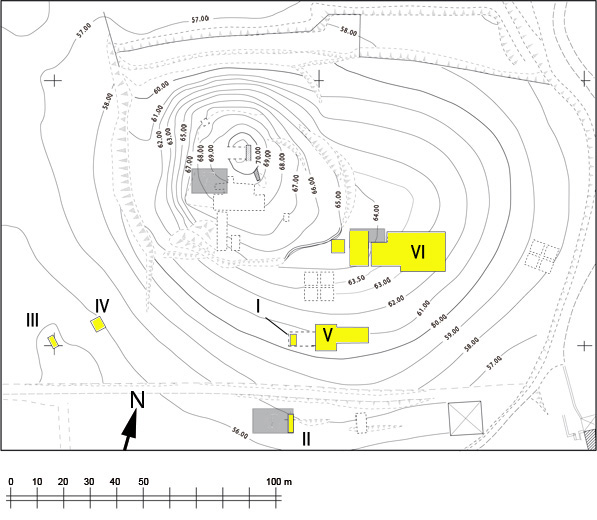The second research program (1986-1996)
 From 1986 until 1996 a second Greek-French research program was conducted under the auspices of the Archaeological Society and the French School at Athens and the direction of Chaido Koukouli-Chryssanthaki and René Treuil. This research was further supported financially by the French Ministry of Foreign Affairs and the Greek Ministry of Culture (18th Ephorate of Prehistoric and Classical Antiquities of Kavala), the French National Centre of Scientific Research (CNRS) and the University of Sorbonne-Paris I.
From 1986 until 1996 a second Greek-French research program was conducted under the auspices of the Archaeological Society and the French School at Athens and the direction of Chaido Koukouli-Chryssanthaki and René Treuil. This research was further supported financially by the French Ministry of Foreign Affairs and the Greek Ministry of Culture (18th Ephorate of Prehistoric and Classical Antiquities of Kavala), the French National Centre of Scientific Research (CNRS) and the University of Sorbonne-Paris I.
Since the stratigraphic sequence was already generally known, the main objective of the new research was to reveal the habitation layers as extensively as possible in order to study the building techniques, the spatial organization of the successive settlements, and the way of life of the inhabitants in general.
Alongside that effort, an attempt was made to investigate the earlier occupation layers down to the natural soil and to reconstruct the site’s environment at the time of the first human settlement.
The Greek team continued research on the eastern side of the mound: a new sector (VI), measuring 565m2, was opened around one of the older sectors of Theocharis where excavation had brought to light well-preserved ruins from the Late Neolithic II and the Early Bronze Age. The French team settled on the south slope of the mound, with a new sector (V, 145m2) next to Deshayes’ sector B1, which had yielded several successive layers of the Late Neolithic I period. Excavations in sectors V and VI revealed, for the first time in the region, a substantial number of Late Neolithic house units.
The two teams also undertook further excavation in a small part of sector Β2 (a deep trench in the West of square AA 28), now defined as sector Ι. Its bottom represented the deepest point reached so far by excavation (57,25 m above sea level) and thus could serve as a starting point for the exploration of earlier layers. However, the excavation did not go beyond 56,80 m, due to the narrowness of the trench, and the only layer that was excavated also dates to the Late Neolithic I.
Finally, a new stratigraphic trench was opened (sector ΙΙ, 14m2) at the southern foot of the tell, but no earlier layers were recovered. This seems reasonable today, especially in light of the results of the geomorphologic research. This research established that the deposits at the periphery of the mound were formed by the erosion of its upper layers; therefore, the dimensions of the initial settlement were smaller than the present mound’s surface. The excavation revealed a strong stone structure in the centre and south of the trench, which might correspond to one edge of the settlement.
A series of geomorphological research was conducted between 1986 and 1994. This program included two small trenches created using heavy machinery on the periphery of the mound (sectors III and IV) and several core-samples in and around the mound. Both provided valuable information about the nature of the geological substrate and the evolution of the landscape.
After eight field seasons
(1986,
1987,
1989,
1991,
1993,
1994,
1995,
1996), excavation stopped in order to facilitate the preparation of the publication.
In many cases, the studies conducted at Dikili Tash served as the basis for or were integrated into broader research projects of multidisciplinary or international character: for example, the program regarding the storage and cooking facilities in the Neolithic and Bronze Age in Northern Greece (a Greek-French cooperation program “Plato”, between the laboratory UMR 7041 of Nanterre and the University of Thessaloniki, 2002-2003); the program about the black-on-red painted Neolithic pottery (CNRS-French School at Athens, 2000-2004); and the research into clay and fire in the prehistoric Aegean (ACI Prosodie of the French Ministry of Research, 2004-2007). Finally, the project has invested in the study of various materials and techniques using the experimental approach.

